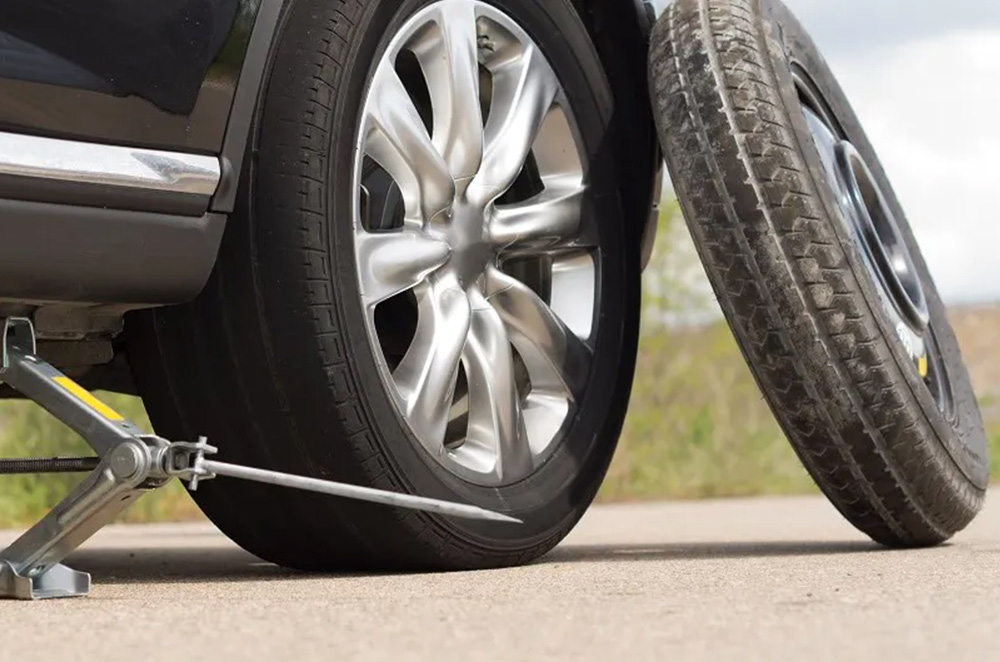
Space-saver tires, also known as donut tires, have long been a staple of the automotive industry. These spares are more compact and cheaper to produce, which bodes well for car companies and consumers. Read on below to find out why cars come with space-saver tires.
History of spare tires

Cars weren’t always packaged with spare tires. The first spares were invented in 1904 by Walter and Tom Davies. Soon after, the Thomas B. Jeffery Company started including spare tires in their cars. These full-size spares were mounted on car exteriors and quickly became part of the aesthetic of the time.
In 1941, however, World War II broke out. The US government quickly banned car manufacturers from producing spare tires for new cars. This ban was due to a worldwide rubber shortage that forced the country to ration supplies. After the war ended, production resumed in full.
Continuous innovation from competing car companies led to the development of the space-saver tire. Introduced in the 1980s by the Volkswagen Automobile Company, this type of spare tire is characteristically smaller, narrower, and has a shallower tread than regular tires. This more compact form factor allowed Volkswagen to save on production costs while giving consumers more room in their trunks.
Following Volkswagen, more and more car manufacturers opted to include donut tires in their cars. Now, space-saver tires are commonplace and invaluable for the automotive industry. In 2017, about half of all new cars produced in the US came with space-saver tires.
When can space-saver tires be used?

Because of their smaller form and lightweight construction, space-saver tires are only recommended for use within short distances. Space-saver tires are designed for emergencies, which means their use is limited to getting you to a repair shop where you can get a full-size tire installed.
When using a space-saver tire, keep in mind that 80 km/h is about as fast as you can go. Going more than a few hundred kilometers on a donut tire is also not recommended. The main reason is that the size and construction of the space-saver spare will negatively affect handling. Space-saver tires have shallower treading and inferior rubber compound, which means that traction is limited and therefore easier for drivers to lose control while using them. Space-savers may also interfere with the braking system and transmission. The imbalance between the regular and space-saver tires may put extra strain on the drivetrain and cause your car to veer off course under hard braking. You may also notice that donut tires typically come in a bright color, usually yellow or orange, to discourage drivers from using the spares for long stretches.
Some of the positives of using a space-saver tire include increased fuel efficiency and lower emissions. However, these changes are not significant enough to warrant using space-saver tires daily.
All in all, space-saver tires are an incredibly useful invention that has helped countless people out of emergencies and mishaps. They're cheaper, lighter, and they maximize trunk space. Although great for shorter distances, space-savers should never be used full-time. Space-saver tires have their time and place, and that is as a temporary spare when there are no other options.
Latest Features
-
How to prepare your car for the Holidays / Featured Article
Here are our handy tips on how to keep you on the road and stress free this holiday season.
-
An all-electric future: The Porsche Macan Electric / Featured Article
Porsche’s Macan goes all-electric; it’s a new beast with an electrified heart, yet unmistakably Porsche in performance and spirit.
-
Which Kia should I buy? / Featured Article
We’re here to help you decide which Kia vehicle is best for you, whether it’s a sedan, crossover, or minivan.
Popular Articles
-
Electric Vehicles in the Philippines for under P1 million
Jerome Tresvalles · Aug 19, 2025
-
Top 3 Cars For Every Lifestyle—What Cars Are Right For You? | Behind a Desk
Caco Tirona · Apr 24, 2024
-
5 Tips to Maximize Fuel Efficiency
Jerome Tresvalles · Sep 09, 2024
-
Five driving habits that are draining your fuel tank
Jerome Tresvalles · Jun 24, 2025
-
Can engine braking harm your engine?
Jerome Tresvalles · Sep 11, 2025
-
Do electric cars even need maintenance?
Jerome Tresvalles · Oct 23, 2024
-
Best vehicles for an active outdoor lifestyle
Shaynah Miranda · Jul 25, 2024
-
How to drive different types of vehicle transmissions
May 23, 2024
-
5 easy ways to keep your car interior clean
Allysa Mae Zulueta · Nov 15, 2021
-
How to survive Metro Manila traffic
Earl Lee · Aug 16, 2022



